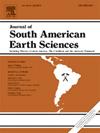陡坡俯冲过程中上新世-全新世岩浆演化
IF 1.7
4区 地球科学
Q3 GEOSCIENCES, MULTIDISCIPLINARY
引用次数: 0
摘要
晚上新世至全新世,中安第斯山脉南部(34-38.5°S)的岩浆活动发生了显著的地球化学变化,并呈现出系统的时空变化。这些变化主要与纳斯卡板块在晚中新世浅俯冲构造后的变陡有关。结果表明,上—全新世岩浆活动发育在现今弧前、弧后和弧后三个南北向岩浆带。本文通过整理上新世—全新世弧后、弧后岩浆序列的地球化学资料(主要元素、微量元素、Sr-Nd-Pb同位素)和年代学资料(Ar-Ar、K-Ar、U-Pb),对纳斯卡板块陡变开始以来的岩浆演化进行了评价。弧后火山层序的类弧地球化学特征从北向南逐渐减弱,不相容元素浓度逐渐增加。这种变化主要归因于地幔源的变化,南部岩浆活动与EM-1 OIB型源有关,北部火山活动与N-MORB型地幔源有关。然而,其他过程,如地幔楔热结构的变化、地壳厚度的沿走向变化和弧前俯冲侵蚀,对于解释其他地球化学特征是必不可少的。另一方面,上全新世弧后岩浆活动的地球化学特征略微反映了弧后岩浆活动的地球化学模式,其北部弧后单元呈现出弧状特征,而南部弧后单元则呈现出早期的板内特征。因此,对于弧后和弧后单元与海沟的距离不同,环境地幔成分的非均质性和地幔楔的热结构等一级控制因素影响了安第斯山脉中南部的岩浆活动。本文章由计算机程序翻译,如有差异,请以英文原文为准。
Plio-Holocene magmatic evolution during a steepening subduction regime
From the late Pliocene to Holocene times, magmatism in the Southern Central Andes (34–38.5 °S) displayed significant geochemical changes that show a systematic variation with both time and location. These changes have primarily been linked to the steepening of the Nazca plate after its shallow subduction configuration in the late Miocene. As a result, Plio-Holocene magmatism developed in three N-S magmatic belts, located within the present-day arc front, the rear-arc, and the back-arc areas. This work presents the compilation of geochemical data (major and trace elements, and Sr-Nd-Pb isotopes) and geochronological data (Ar-Ar, K-Ar, U-Pb) from the Plio-Holocene rear-arc and back-arc magmatic sequences to evaluate the magmatic evolution since the beginning of the Nazca plate steepening in the latest Pliocene.
The back-arc volcanic sequences show a decrease in arc-like geochemical features and an increase in the concentration of incompatible elements from the northern to the southern back-arc units. This change has primarily been attributed to variations in the mantle source, with southern magmatism associated with an EM-1 OIB type source and northern volcanism related to an N-MORB mantle source. However, other processes, such as changes in the thermal structure of the mantle wedge, along-strike variations in crustal thickness, and forearc subduction erosion, are essential to explain other geochemical features. On the other hand, the geochemistry of the Plio-Holocene rear-arc magmatism slightly reflects the geochemical patterns of the back-arc magmatism, as the northern rear-arc units present arc-like features, while the southern rear-arc shows an incipient intraplate-like signature. Thus, regarding the varying distances to the trench between back-arc and rear-arc units, first-order controls such as heterogeneities in ambient mantle composition and the thermal structure of the mantle wedge have influenced the magmatism of the Southern Central Andes.
求助全文
通过发布文献求助,成功后即可免费获取论文全文。
去求助
来源期刊

Journal of South American Earth Sciences
地学-地球科学综合
CiteScore
3.70
自引率
22.20%
发文量
364
审稿时长
6-12 weeks
期刊介绍:
Papers must have a regional appeal and should present work of more than local significance. Research papers dealing with the regional geology of South American cratons and mobile belts, within the following research fields:
-Economic geology, metallogenesis and hydrocarbon genesis and reservoirs.
-Geophysics, geochemistry, volcanology, igneous and metamorphic petrology.
-Tectonics, neo- and seismotectonics and geodynamic modeling.
-Geomorphology, geological hazards, environmental geology, climate change in America and Antarctica, and soil research.
-Stratigraphy, sedimentology, structure and basin evolution.
-Paleontology, paleoecology, paleoclimatology and Quaternary geology.
New developments in already established regional projects and new initiatives dealing with the geology of the continent will be summarized and presented on a regular basis. Short notes, discussions, book reviews and conference and workshop reports will also be included when relevant.
 求助内容:
求助内容: 应助结果提醒方式:
应助结果提醒方式:


